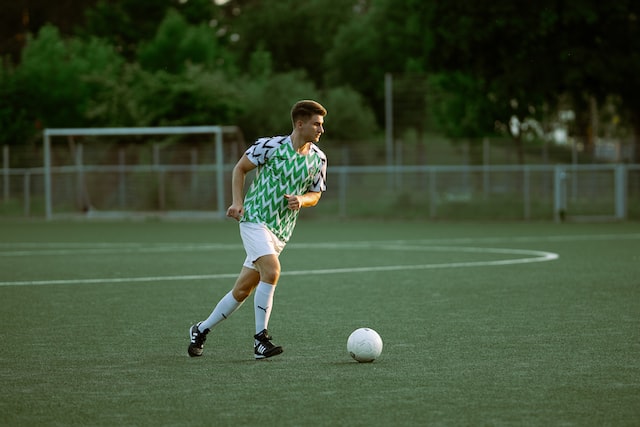As soccer evolves, so do the positions within the sport. The dynamic nature of the game means that managers are ever-increasingly looking for balance in their line-ups, and what better way to achieve that than employing an anchorman?
For all the clamor to see attacking talents putting on a show, it’s important to remember the work that goes on deeper in the midfield, a lot of which can be just as pleasing to spectators.
Let me introduce you to the anchorman role, a crucial component of a successful team that should never be ignored.
So, what is an anchorman?
An anchorman is a midfielder who typically sits deeper than the other midfielders to mop up any danger before it reaches the defense.
Your anchorman is the protective barrier in front of your side’s defense. These players are usually adept at tackling and not afraid to get physical.
Often regarded as a team’s safety net, the anchorman rarely joins attacks, instead protecting their side from counter-attacks. They are the linchpin for the midfield, maintaining the team’s shape and allowing creative freedom for their teammates.
Once the anchorman has won the ball back, they typically give the ball to one of their more technically imaginative teammates who possesses more attacking intent.
Why do you need an anchorman in soccer?
Your side could benefit from having an anchorman because having different midfield tiers makes breaching your guard all the more difficult.
Rather than fielding ‘all-rounder’ midfielders expected to perform an array of jobs up and down the pitch, having a midfielder whose primary responsibility is to sniff out and extinguish danger can be a priceless asset to frustrate attacks.
Because your opposition is likely to restrict the avenues of access to your attackers or attacking midfielders, having someone performing this role in your team can act as a metronome, dictating the tempo at which your passing game is played.
When your side is in possession, and you can’t find any options further up the field, it’s wise to keep the ball moving and keep the opposition chasing the ball and your players.
Your anchorman can serve as an often-available option to reset and then perhaps look to switch the play to the other side of the field to explore opportunities there.
What skills and attributes does an anchorman need?
An anchorman needs a high degree of anticipation, sensing trouble from threats that might not be apparent to other types of players. There’s no doubt that understanding what your opponent wants to do is the best approach to stopping them and means you can work on ways to try and outsmart them.
This role also requires a player with good tackling ability. To win the ball back from your opponent takes tenacity and determination, of course, but there is an art to tackling which involves accurate timing and agile body movement.
Physicality is being penalized more and more in the modern game, so tacklers need to remain smart in the challenges they go into. With the speed at which soccer is played increasing all the time as well, tacklers must slow down rather than fly through their opponent for their safety.
Remaining goal-side (closer to your own goal than your opponent) means putting yourself, as the anchorman, between your opponent and your goal. Apart from obviously blocking their route to the goal, it also means you shouldn’t have to make many tackles from behind, which is a common way of getting booked.
Is an anchorman the same as a defensive midfielder?

The anchorman is a type of defensive midfielder, but other types of midfielders occupy the defensive zones too.
For instance, certain playmakers like to sit deep to pull the strings as playmakers. In Italy, they call this type of defensive midfielder a “Regista.” These conductors are more attuned to incisive passes rather than dogged defending.
Of course, there are defensive midfielders who are very good at both, so it’s difficult to pigeonhole those players as one type of defensive midfielder or another.
Different managers might feel that their side would benefit from having an anchorman over a deep-lying playmaker, or vice versa.
If your side wants an attractive style of play and will not have to defend too much in a game, a deep-lying playmaker could be the best option.
However, if you feel that the team you’re facing has a dangerous attacking midfielder who can create chances, it would be a good idea to restrict the space they have to operate in by dedicating an anchorman to occupy that space and shadow the player.
Wondering how to set up your team against tough opponents? Check out our article, where we explain the best soccer formations for weak teams.
Five of the best anchormen in soccer
- Rodri, Manchester City – the acquisition of Rodri was a masterstroke for a manager that wants to dominate possession as much as Pep Guardiola does. The Spaniard duly obliged by becoming the beating heart of everything Pep Guardiola’s side does with his relentless hounding of attackers and rhythmic passing skills.
- Casemiro, Manchester United – this was a position the Red Devils needed to address, and they landed one of the best around in this role. Casemiro has been incredibly successful throughout his trophy-laden spell at Real Madrid. His tenacity was a huge reason they won five Champions League titles and complemented the attacking flair the rest of the team possessed perfectly.
- Joshua Kimmich, Bayern Munich – Kimmich is an interesting example, mostly because his early professional career saw him deployed as a right-back, despite playing defensive midfield at the youth level. Yet, when converted back into an anchorman, he proved to the world that he hadn’t lost his intercepting prowess and ability to command the defensive midfield area.
- Fabinho, Liverpool – as skillful as the Brazilian is, he’s equally as combative when it comes to the dirty work. His large build and disciplined demeanor are a frightening prospect for opponents, who’d do well to bypass the Reds’ enforcer, who seems to be everywhere all the time.
- N’Golo Kanté, Chelsea – Kanté is a prime example of a non-stop, energetic defensive midfielder who swarms over the opposing team, hassling them into submission. He was instrumental in Leicester City’s shock title win in 2016, then followed that up with another Premier League medal the next year following his move to Chelsea.
Recap: The anchorman in soccer
Players capable of operating in the anchorman role offer great value to sides looking to stifle the other team’s threat and provide your side with solidity.
Now that we’ve assessed the capabilities and responsibilities of an anchorman, managers can make an informed decision about whether to incorporate the role into their team.

